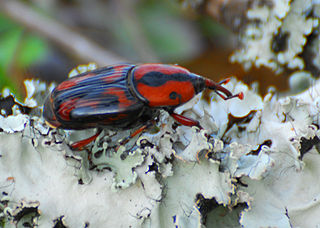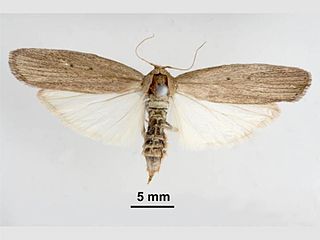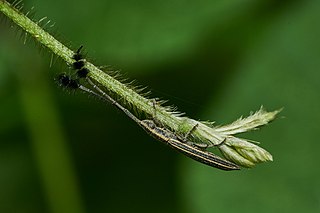
The Curculionidae are a family of weevils, commonly called snout beetles or true weevils. They are one of the largest animal families with 6,800 genera and 83,000 species described worldwide. They are the sister group to the family Brentidae.

Phoenix is a genus of 14 species of palms, native to an area starting from the Canary Islands in the west, across northern and central Africa, to the extreme southeast of Europe (Crete), and continuing throughout southern Asia, from Anatolia east to southern China and Malaysia. The diverse habitats they occupy include swamps, deserts, and mangrove sea coasts. Most Phoenix species originate in semi-arid regions, but usually occur near high groundwater levels, rivers, or springs. The genus is unusual among members of subfamily Coryphoideae in having pinnate, rather than palmate leaves; tribe Caryoteae also have pinnate or bipinnate leaves.

Bookworm is a general name for any insect that is said to bore through books.

A bark beetle is the common name for the subfamily of beetles Scolytinae. Previously, this was considered a distinct family (Scolytidae), but is now understood to be a specialized clade of the "true weevil" family (Curculionidae). Although the term "bark beetle" refers to the fact that many species feed in the inner bark (phloem) layer of trees, the subfamily also has many species with other lifestyles, including some that bore into wood, feed in fruit and seeds, or tunnel into herbaceous plants. Well-known species are members of the type genus Scolytus, namely the European elm bark beetle S. multistriatus and the large elm bark beetle S. scolytus, which like the American elm bark beetle Hylurgopinus rufipes, transmit Dutch elm disease fungi (Ophiostoma). The mountain pine beetle Dendroctonus ponderosae, southern pine beetle Dendroctonus frontalis, and their near relatives are major pests of conifer forests in North America. A similarly aggressive species in Europe is the spruce ips Ips typographus. A tiny bark beetle, the coffee berry borer, Hypothenemus hampei is a major pest on coffee plantations around the world.

The palm weevil Rhynchophorus ferrugineus is one of two species of snout beetle known as the red palm weevil, Asian palm weevil or sago palm weevil. The adult beetles are relatively large, ranging between 2 and 4 centimetres long, and are usually a rusty red colour—but many colour variants exist and have often been classified as different species. Weevil larvae can excavate holes in the trunks of palm trees up to 1 metre (3.3 ft) long, thereby weakening and eventually killing the host plant. As a result, the weevil is considered a major pest in palm plantations, including the coconut palm, date palm and oil palm.

Rhyzopertha is a monotypic genus of beetles in the family Bostrichidae, the false powderpost beetles. The sole species, Rhyzopertha dominica, is known commonly as the lesser grain borer, American wheat weevil, Australian wheat weevil, and stored grain borer. It is a beetle commonly found within store bought products and pest of stored cereal grains located worldwide. It is also a major pest of peanuts. The first documentation of wheat infestation by R. dominica was observed in Australia. R. dominica are usually reddish brown to dark brown in coloration, vary in sizes, elongated and cylindrical.

A pheromone trap is a type of insect trap that uses pheromones to lure insects. Sex pheromones and aggregating pheromones are the most common types used. A pheromone-impregnated lure is encased in a conventional trap such as a bottle trap, Delta trap, water-pan trap, or funnel trap. Pheromone traps are used both to count insect populations by sampling, and to trap pests such as clothes moths to destroy them.

The palmetto weevil is an insect native to Florida, but has been found as far as southern Texas to the west and South Carolina to the north. It is the largest weevil in North America and the only kind of palm weevil in the continental United States. It infests palms and is considered a pest. Its main target is the Canary Island date palm, but date palms, sabal palms, saw palmetto, Washingtonia, Pritchardia, royal palms, Latania, coconut palms, Caryota, and Bismarckia are also susceptible. Distressed palm trees are usually attacked, which makes transplanted trees a frequent target. The Palmetto Weevils mate at the base of the palm branches where the females deposit their eggs. The grubs then eat into the palm tree, killing it. After the larvae have turned into adult weevils, the damage can be seen, but by then, it is considered to be too late for the tree. The life cycle from egg to adult for a palmetto weevil is about 84 days. For prevention, it is recommended an appropriate insecticidal crown drench is done twice a year for high value palms.

The palm weevil Rhynchophorus vulneratus is one of two species of snout beetle known as the red palm weevil, Asian palm weevil, or Sago palm weevil. The adult beetles are relatively large, ranging between 2 and 4 centimetres long, and vary from a rusty red colour to almost entirely black; many colour variants exist and have led to considerable confusion with other species. Weevil larvae of these species can excavate holes in the trunk of a palm tree up to 1 metre long, thereby weakening and eventually killing the host plant. As a result, these weevils are considered major pests in palm plantations, including the coconut palm, date palm and oil palm.

Eldana is a genus of moths of the family Pyralidae containing only one species, the African sugar-cane borer, which is commonly found in Equatorial Guinea, Ghana, Mozambique, Sierra Leone and South Africa. Adults have pale brown forewings with two small spots in the centre and light brown hindwings, and they have a wingspan of 35mm. This species is particularly relevant to humans because the larvae are a pest of the Saccharum species as well as several grain crops such as sorghum and maize. Other recorded host plants are cassava, rice and Cyperus species. When attacking these crops, E. saccharina bores into the stems of their host plant, causing severe damage to the crop. This behavior is the origin of the E. saccharrina's common name, the African sugar-cane borer. The African sugar-cane borer is a resilient pest, as it can survive crop burnings. Other methods such as intercropping and parasitic wasps have been employed to prevent further damage to crops.

Rhynchophorus, or common name palm weevils, is a genus of beetles in the weevil family, Curculionidae. Palm weevils are major pests of various trees in the family Arecaceae throughout the tropics including: coconut, Areca catechu, species of the genus Phoenix, and Metroxylon sagu. Two species are invasive pests outside their native ranges, Rhynchophorus ferrugineus and Rhynchophorus palmarum.

The South American palm weevil, Rhynchophorus palmarum, is a species of snout beetle. The adults are relatively large black beetles of approximately one and a half inch in length, and the larvae may grow to two inches in length.
The Coconut black headed caterpillar, is a species of moth found in throughout East Asian countries including Bangladesh, India, Sri Lanka, Myanmar, as well as Indonesia. It is considered a pest of coconut palm trees, causing considerable damage to the trees, and reducing the plant's yield significantly and can be a major problem where coconuts contribute to the economy. The species exists on coconut palms through its life stages from larval to moth, and utilizes the tree fronds as a main source of nutrition. Various methods of control have been explored, yet the primary control method is the administration of pesticides directly to the root of the coconut palms.

Sternochetus mangiferae is a weevil commonly known as the mango seed weevil, mango stone weevil, or mango weevil. It is a compact weevil typical of the Cryptorhynchinae. It was first described in 1775 in the genus Curculio. The adults are 7.5-9.5 mm long and 4 mm in width.

A stemborer is any insect larva, or arthropod, that bores into plant stems. However the term most frequently refers among the Coleoptera to the larva of certain longhorn beetles such as Dorysthenes buqueti and those of the genus Oberea, and among the Lepidoptera to certain moths of the Crambidae, Castniidae, Gelechiidae, Nolidae, and Pyralidae families.
A storage pest is an insect or other animal that damages or destroys stored food or other stored valuable organic matter. Insects are a large proportion of storage pests with each type of crop having specific insects that gravitate towards them such as the genus Tribolium that consists of insects such as Tribolium castaneum or Tribolium confusum which damage flour crops primarily.

Oemona hirta, the lemon tree borer, also known as the whistling beetle or the singing beetle, is a longhorn beetle endemic to New Zealand. Its larvae are generalist feeders, boring into the wood of a wide variety of trees, native and introduced. When citrus orchards were first established in New Zealand, this beetle started inflicting serious damage, and so gained the name "lemon tree borer". Four species within the genus Oemona have been identified, suggesting that more species could be found. When disturbed by predators or humans, the adult beetle stridulates creating a "rasp" or "squeak" sound by rubbing its thorax and head together against an area of thin ridges. Māori would eat a liquid called "pia manuka", which was produced by manuka trees when its wood was damaged by the larvae. When Captain Cook first arrived in NZ, his naturalists, Banks and Solander, collected a lemon tree borer in their first collection between 1769 and 1771. This oldest collected specimen can be found in the British Museum. A few years after the first collection, the species would be first described by the Danish naturalist Fabricius in 1775.

Cosmopolites sordidus, commonly known as the banana root borer, banana borer, or banana weevil, is a species of weevil in the family Curculionidae. It is a pest of banana cultivation and has a cosmopolitan distribution, being found in all parts of the world in which bananas are grown. It is considered the most serious insect pest of bananas.

Odoiporus longicollis, commonly known as banana stem weevil or banana pseudostem borer, is a species of weevil found in South Asia and South East Asia.
Euwallacea perbrevis, commonly known as tea shot-hole borer, is a species of weevil native to South and South-East Asia through to Australia, but introduced to Western countries.
















